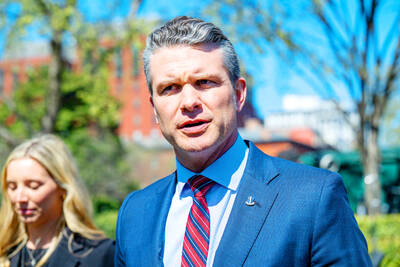Besides traditional sightseeing tours that take visitors to Sun Moon Lake and the mountainous region of Alishan (阿里山), the nation is also drawing tourists that are seeking to become healthier and more physically attractive.
In Hualien, an area traditionally known more for its coastal scenery than medical services, 67 medical institutions and travel operators recently started offering high-end medical packages aimed at Chinese tourists.
Priced at NT$500,000, the seven-day package features a combination of Western-style physical checkups and clinical cosmetology, as well as Chinese preventive medicine.
A 14-day package features even higher-end healthcare and anti-aging treatment for double the price, according to a county international medical tourism association established by the local government.
The Buddhist Tzu Chi General Hospital in Hualien also offers interesting services in the field of medical tourism.
The hospital made a name for itself by making people’s legs slimmer through a calf muscle trimming procedure, which has been drawing tourists from as far as Brazil.
Since 2001, the hospital has conducted the procedure on 500 people.
Of all the medical tourists visiting the hospital, 20 percent are from China, Hong Kong, Macau, the US, Canada and Japan.
What is happening in Hualien is part of a larger development across the nation, where policymakers are increasingly attaching importance to medical tourism as a new niche market and a way to boost the country’s economy.
According to the Taiwan External Trade Development Council (TAITRA), the nation’s top trade promoter, Taiwan received 81,462 medical tourists by the end of the third quarter of last year, more than double the 39,428 visitors who came in 2011.
Among those treated last year, 60 percent came for treatment, 27 percent for health check-ups and 13 percent for cosmetic surgery, TAITRA said.
In December last year, Minister without Portfolio Kuan Chung-ming (管中閔) proposed setting up a “service industry experimental zone” near Taiwan Taoyuan International Airport that would offer “derivative services from tourism.”
The “derivative services” could include the travel, shopping, clinical cosmetology and financial services sectors and would cater to the needs of international visitors.
Kuan said the idea was part of efforts aimed at boosting employment by cultivating the service industry.
The Council for Economic Planning and Development also floated the idea of “free economic demonstration zones” that would foster the transformation of Taiwan into a regional hub of critical medical care and medical tourism, industrial innovation, international logistics, global talent training and agricultural product sales.
Meanwhile, the nation has been striving to attract more medical tourists from China, given the two countries’ linguistic and cultural similarities, observers said.
According to TAITRA, 3 million people undergo plastic surgery in China every year.
The market for cosmetic surgery in China has grown by 10 percent annually and had surpassed the global average of 6 percent, TAITRA said. Taiwan also launched a 15-day medical tourism visa in January last year to cater to Chinese tourists.
In August last year, the government also promoted an e-visa service to make it easier for Chinese tourists to visit Taiwan for physical checkups, cosmetic surgery or anti-aging treatments.
Taiwan received a total of 50,376 medical tourists from China last year.

‘DENIAL DEFENSE’: The US would increase its military presence with uncrewed ships, and submarines, while boosting defense in the Indo-Pacific, a Pete Hegseth memo said The US is reorienting its military strategy to focus primarily on deterring a potential Chinese invasion of Taiwan, a memo signed by US Secretary of Defense Pete Hegseth showed. The memo also called on Taiwan to increase its defense spending. The document, known as the “Interim National Defense Strategic Guidance,” was distributed this month and detailed the national defense plans of US President Donald Trump’s administration, an article in the Washington Post said on Saturday. It outlines how the US can prepare for a potential war with China and defend itself from threats in the “near abroad,” including Greenland and the Panama

The Chinese Nationalist Party (KMT) is maintaining close ties with Beijing, the Democratic Progressive Party (DPP) said yesterday, hours after a new round of Chinese military drills in the Taiwan Strait began. Political parties in a democracy have a responsibility to be loyal to the nation and defend its sovereignty, DPP spokesman Justin Wu (吳崢) told a news conference in Taipei. His comments came hours after Beijing announced via Chinese state media that the Chinese People’s Liberation Army’s Eastern Theater Command was holding large-scale drills simulating a multi-pronged attack on Taiwan. Contrary to the KMT’s claims that it is staunchly anti-communist, KMT Deputy

RESPONSE: The government would investigate incidents of Taiwanese entertainers in China promoting CCP propaganda online in contravention of the law, the source said Taiwanese entertainers living in China who are found to have contravened cross-strait regulations or collaborated with the Chinese Communist Party (CCP) could be subject to fines, a source said on Sunday. Several Taiwanese entertainers have posted on the social media platform Sina Weibo saying that Taiwan “must be returned” to China, and sharing news articles from Chinese state media. In response, the Mainland Affairs Council (MAC) has asked the Ministry of Culture to investigate whether the entertainers had contravened any laws, and asked for them to be questioned upon their return to Taiwan, an official familiar with the matter said. To curb repeated

Myanmar has turned down an offer of assistance from Taiwanese search-and-rescue teams after a magnitude 7.7 earthquake struck the nation on Friday last week, saying other international aid is sufficient, the National Fire Agency said yesterday. More than 1,700 have been killed and 3,400 injured in the quake that struck near the central Myanmar city of Mandalay early on Friday afternoon, followed minutes later by a magnitude 6.7 aftershock. Worldwide, 13 international search-and-rescue teams have been deployed, with another 13 teams mobilizing, the agency said. Taiwan’s search-and-rescue teams were on standby, but have since been told to stand down, as